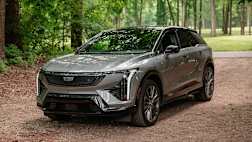Land Rover wants you to know just how hugely massive and life-changing the arrival of its all-new, very new, totally new Discovery is, and they weren't holding back on the hyperbole when it was unveiled it to the world's media in Utah early this year.
Without a trace of humility, and with very straight, British faces, the various spokesheads described what had been achieved as "re-engineering engineering itself" and, if that wasn't enough, "re-designing design" as well.
The truly revelatory Discovery boasts a body of "aerospace level" lightweight aluminium, which is apparently as easily recyclable as a Coke can.
It has sports-car like "nearly 50-50 weight distribution", and improved aerodynamics that give it lower drag and better fuel-economy, an effort aided by new diesel engines, a V6 and two four-cylinder options, which must surely work harder than Trump's hairdresser to get a two-tonne-plus vehicle (it used to be 2200kg-plus, but it's shed 20 per cent of its weight) up hills.
And even harder with seven adults on board (one of the new car's thousands of big selling points is the ability to carry full size human beings in the third row).
And this "Digital Discovery", as they call it, has the kind of tech that will appease the hugely device-addicted younger generations, with a range of bespoke 'apps', including one that allows you to reconfigure the Discovery's seven seats remotely "from anywhere in the world". Because who knows how often that will come in handy?
Clearly, this is a major event, so - after finally driving the Discovery on Australian roads at its recent local launch at Uluru - we've decided to take a deep dive into the detail, and uncover whether Land Rover really has reinvented the wheel, of four-wheel driving at least.
Land Rover Discovery 2017: Td6 First Edition
| Engine Type | Diesel Turbo V6, 3.0L |
|---|---|
| Fuel Type | Diesel |
| Fuel Efficiency | 7.2L/100km (combined) |
| Seating | 5 |
| Price From | $51,260 - $58,960 |
History
The Discovery has been "the centre of gravity for Land Rover Australia", according to the people who work there, who are deeply thrilled to see a new sales leader lobbing down under.
The local mob has sold around 140,000 vehicles since kicking off here in 1991, and 65,000 of those have been Discoveries; so pretty much every second car they sell.
The Disco, as its affectionately known, or 'Project Jay' to give it its original code name, goes back even further, having been unveiled at the Frankfurt motor show back in 1989, where it wowed punters with its boxy and utilitarian design.
.jpg)
Amazingly, at the time Discovery 1 succeeded despite a rattly turbo-diesel engine that made just 83kW. And the fact that it had just two doors.
Discovery 2, launched in 1998, had five doors and a V8, thirsty but powerful as was the way back then. It represented what Land Rover now calls "a revolution", with a claimed 720 "differences" from the original, with almost every panel changed.
It still looked like a box, though.
The Discovery 3 was unveiled in 2004 and maintained the boxy design tradition, throwing in an asymmetrical rear-end for extra visual challenge.
While the Disco had been famous from day one for its incredible off-road capability, and split personality as a decent road car, this one was a big leap forward, with the introduction of electronic air suspension, which allowed you to go into a raised, off-road mode at the flick of a switch.
They also had Jaguar engines, which was a Very Good Thing, and other clever tech like 'Hill Descent Control' and '4-wheel Electronic Traction Control and DTC'. Best of all, though, was 'Terrain Response', which quite simply made tough off-roading something any idiot could do, with ease.
In 2012, the one millionth Discovery rolled off the production line at Solihull in England's West Midlands, and was sent immediately off on an epic drive to Beijing.
The Discovery 4, which arrived in 2009, carried a more imposing presence and a plusher interior, which was much loved by drug dealers and gangsters the world over.
This model set out to address the reliability issues the nameplate had become somewhat famous for. By now you could also get a V8 making 287kW or a TDV6 with 180kW/600Nm.
In 2012, the one millionth Discovery rolled off the production line at Solihull in England's West Midlands, and was sent immediately off on an epic drive to Beijing.
The Discovery is, particularly in the SUV world, a global icon, and a byword for adventures and derring-do. It's also become something of a suburban stand-by for mums around Australia, who love its 'command seating position' to bits.
The latest, and most Range Rover-like, Discovery was first seen in 2016 and has just started turning up on Australian roads, where it is eagerly awaited, with almost 700 pre-orders on the books. The legend lives.
Design
Undeniably attractive from front on, or a three-quarter view, there's definitely something divisive and, shall we say, 'brave', going on at the rear of the new Discovery, where it looks like a slightly dodgy builder has come in and slapped on a porch with an awning.
There's a reason for the extended roofline, of course, and an entirely understandable one; it's there so fully grown humans can sit in the third row of the seven-seat versions and have actual headroom. The fact that it’s a trade-off, in terms of beauty, is not something you'll ever get Gerry McGovern, Land Rover's chief design officer, to admit.
He sees nothing but beauty in the rear balcony addition and says it "alludes to the Discovery's roots".
.jpg)
"It hasn't always been known for great design in the past, but I want it to be known for design, because that’s what brings customers to the brand - I believe design has the ability to enrich people's lives, and that this Discovery is less polarising and more universally appealing," McGovern oozed to us.
He claims the Discovery looks smaller than it is (and it is vast, at almost 5.0m, or 4970mm long, 2220mm wide and 1846mm tall) thanks to "visual trickery".
"There's a lot of drama in the vehicle, and visible robustness, but it's also about presenting modernity and the premiumness of the vehicle," McGovern added.
"New Discovery redefines the large SUV. We truly believe the result is a radical departure in design that will introduce the Discovery family to a new, wider customer base."
McGovern is not wrong when he says Discovery has not always been known for its looks, with past models never particularly easy on the eye. But this new version really is a leap ahead, at least from most angles, with the kind of curvature and dynamic detail that seemed optimistic when Land Rover unveiled the Discovery Vision Concept at the New York Auto Show back in 2014. But they have really delivered.
After several days driving and staring at them now, I have to say the rear is bothering me a lot less than it used to and it is, overall, a hell of good looking thing, for a vehicle of its vast dimensions.
On the inside
Land Rover claims "any seat is the best seat in the house" in the new Discovery, which suggests any adults lucky enough to sit in the third row will be just as happy as the person in the driver’s seat.
This is something of an exaggeration, obviously, but the Disco can fairly claim to be one of the few seven-seaters that’s actually comfortable enough for adults to do long distances in the back.

Space and comfort are excellent in the middle row - with a metre of legroom - and as long as those passengers are happy to slide their bench slightly forward, those in the third row can enjoy genuine knee room, and decently padded cushions beneath them as well.
The designers also did plenty of research about car-sickness, particularly in children, and the findings were that sight-lines for those in the rear seats can make a big difference to the incidence of nausea. The result is a stadium-seating plan that allows even those in the third row to be able to see the dash, and the road ahead of it.
On those probably more common occasions when you don't have that many people with you, the Discovery offers a whopping 21 different seat configurations, all of which can be controlled remotely using the touch-screen dash, the buttons in the tailgate or the app on your mobile phone, if you really want to show off your love of pointless things.
Speaking of which, all the seats in the car are described as “Intelligent” by Land Rover, which says they incorporate weight sensors and "artificial intelligence", which helps to apply seat-control algorithms.
In practice, what this means is that if you’re trying to move a seat from outside the car and you've forgotten your shopping is in there and about to be flattened, the intelligent seats will notice, and save your avocados from being smashed too soon.
The Discovery also has a merely "clever" tailgate, which folds down remotely and can hold up to 300kg, meaning you and your partner can park there to watch the polo.
Behind you sits a vast cavern of space, which offers a whopping 2500 litres of storage space with all the rear seats folded to offer a big, flat floor.
.jpg)
The interior designers' self-confessed "obsession with storage" has led to the Discovery offering no fewer than 21 separate storage areas, including a bin big enough to hold four iPads between the front seats, an ingenious little hidden nook behind the air-conditioning controls (which fold down to reveal the space at the push of a button) with 1.4 litres of storage for your wallet or phone, and a wet storage area hidden under the rear loading floor.
You also get nine USB points and six 12-volt chargers, because kids these days.
This is also the most technically advanced Discovery ever, which means not just a Wi-Fi hot spot but a feast of 'Incontrol Apps', accessible through the plushly realised 10.0-inch 'Touch Pro' screen. It's linked to a system with 60 gigabytes of storage, for all your media, and you can even stream to that screen, or other optional ones on the seatbacks, from your device.
.jpg)
The central screen also offers the ingenious 'Dual View' ,which means the passenger can watch a movie from where they’re sitting, but the driver can only see the sat nav, for example.
Those apps allow you to share your ETA with friends by text, select a destination on your phone at the breakfast table and send it to your sat nav via the cloud, so it's ready when you get in, and the ability to set the temperature in the cabin before you get to the door, using your Apple Watch.
Other highlights are an app to help you find your Disco in a crowded car park (as if its sheer size won't help with that), a weather app that tells you what conditions will be like when you arrive at your destination and a 'News Reader', which puts up headlines on the screen and will then read out whole stories at your command (at least if you're in America).
You even get a 'curry hook' – introduced on the original Discovery for English people wanting to bring a take-away curry home without spilling the butter chicken. The hook is now secreted at the side of the transmission tunnel. Push it open and it’s spring loaded to pop out when needed, and hold your take-away bags tightly all the way home.
.jpg)
In the interests of embiggening, the door bins are now so large they can accommodate a two-litre bottle.
You can also choose an 'Activity Key', which is a little rubber wrist band, water proof up to 50m, that allows you to lock your keys in the car. You just wave your wrist at a certain point on the rear tailgate, after you’ve done your rugged exercising, and it lets you back in.
There's so much clever going on, you can see why the PR people were excited.
Under the skin
The emission-driven demands of the modern world meant the new Discovery had to be lighter and use smaller engines than ever before, but it would also have to be physically larger.
The answer to this tricky challenge was using what Land Rover calls "aerospace levels of aluminium", with 85 per cent of the body structure made of the stuff. Amazingly, up to 50 per cent of the sheet aluminium used is made from recycled material.
Overall weight has dropped a whopping 480kg, to a still substantial 2105kg.
Another benefit is body rigidity, with Land Rover claiming this is the stiffest Disco ever, offering much improved body control.
The entire bodyside of the vehicle, and the underside, are pressed as single aluminium panels, meaning fewer joints and much improved structural integrity.
Alex Heslop, chief product engineer, says: "New Discovery has been designed and engineered around our full-sized SUV architecture to ensure we have built-in, world-beating all-terrain capability."
The way the big Discovery drives on the road was also a particular focus for the engineers, and it really is one of those cars that defies its weight and dimensions to feel smaller, lower and sportier than would seem possible. Although it doesn't eliminate body roll, sadly.
This is helped enormously by cleverly tuned speed-dependent, electric power-assisted steering. It’s not overly involving, and certainly not Porsche-like, but it provides enough muscular feedback to make tackling a series of bends up a mountain pass an enjoyable experience.
Suspension
The redesigned suspension is mounted on steel subframes front and rear, for extra stiffness and the toughness to withstand off-road impacts.
A lot of work has also been done to make the chassis performance and steering response sportier, or more Range Rover like.
The fully independent suspension uses a double-wishbone layout at the front and an advanced multi-link layout with an integral link at the rear. The integral link allows engineers to achieve stiffer damping when necessary for superior body control.
Almost every car sold will come with air suspension, even though it's optional on the base model, which also adds luxurious comfort and off-road genius.
The system automatically drops you to the lowest setting once your speed exceeds 110km/h, for better aero - and thus fuel efficiency - as well as better handling.
Engines
In theory, you should be laughed right out of Dodge for telling people these hulking, mountain-climbing behemoths could be powered by engines of just 2.0 litres and four cylinders, but today we know small diesels are capable of just about anything.
At the base model end of things, where almost no one will shop, there's a 2.0-litre 'Ingenium' Jaguar Land Rover diesel engine delivering the kind of fuel-economy and emissions figures that would have seemed absurd a decade ago.
The Td4 base engine delivers a claimed fuel figure of just 6.3L/100km, and CO2 emissions of just 163g/km.
While 132kW certainly doesn't sound like a lot for a two-tonne vehicle, the handy 430Nm should be a big help, particularly when it comes to towing, or climbing hills.
While a 0-100km/h time of 10.5 seconds sounds a little tardy, it's worth pointing out that the outgoing TDV6 Discovery could only do the same in 10.7sec.
The Ingenium engine uses high-pressure, common rail direct fuel injection operating at up to 1800bar, via solenoid injectors. Its single turbocharger uses 'Variable Nozzle Turbine' technology and a high-efficiency water-cooled intercooler.
Diesel refinement was also a goal for the engineers, to maintain what is a quiet and luxurious cabin feel. The engines sit on dual-isolated mounts and use variable act thing on the exhaust side and twin balancer shafts for reduced clattering.
The aluminium engines are also light-weight in construction and use stiff cylinder blocks with decoupled injectors for lower noise and vibration.
Same size, more power - the Sd4

If you want to save the planet, but you’re also in a hurry, you'll want to step up to the more powerful version of the 2.0-litre diesel, the Sd4, which is the first JLR powerplant to use sequential turbo technology for additional thrustiness.
How much extra thrust? Well, you’ll be getting to 100km/h more than two seconds quicker, at 8.3sec, thanks to your 177kW/500Nm. This, essentially, is the engine that replaces the old 3.0-litre SDV6 diesel.
The payoff of the downsizing, of course, is the 6.5L/100km fuel-economy figure, and the 171g/km CO2.
A hit for six - the Td6

At the top of the Discovery tree sits the new version of the V6 turbo-diesel, the Td6, which uses a single turbo featuring low-pressure exhaust recirculation, a two-stage oil pump and revised fuel-injector nozzle for improved response, better refinement and, of course, fuel efficiency.
The CO2 figure drops seven per cent to 189g/km, while fuel economy is just 7.2L/100km, so close to the four-cylinder you really can justify the extra grunt, which comes in at 190kW/600Nm.
You won't be much faster than the new 2.0, though, at just 8.1 seconds to 100km/h, although that figure is 1.3 seconds faster than the old TDV6.
All three engines are paired with a seamlessly smooth shifting eight-speed ZF automatic transmission, which is very much high-end Germanic in the way it swaps cogs without you noticing. You can choose to shift yourself, using paddles on the steering wheel, which comes in handy for low-speed, rough-road adventures.
Fuel efficiency is also enhanced on all models by the new, slipperier design, with a drag coefficient of just 0.33 (a 17 per cent improvement), plus stop-start tech with smart regenerative charging.
There’s also an 'ECO Data' system that shows you real-time fuel-economy numbers on the central touchscreen and will offer driving trips on how to further improve your efficiency.
In the real world, the V6 is the best engine, purely because its torque is best equipped to cope with all that mass, and particularly if you're carrying seven adults at any stage.
Off-road ability
Cosseted in your quiet and refined cabin, there's a genuine sense of the bizarre when you throw the Discovery at some proper off-road challenges. The things it can do, and the ease with which it does them, seems completely out of step with the aura of the rest of the car.
It's like choosing a thoroughbred race horse to trek you down the steep shale sides of the Grand Canyon. Only more comfortable.
It's also quite shocking how easy it all is from the driver's seat, because the computers really are doing all the work for you, particularly if you use 'All Terrain Progress Control'. So much so that you can just sit there, your feet both tapping a tune to something on the excellent stereo, while the Discovery drives itself up a boulder bash, or down a stupidly steep sand dune. It's basically cruise control for off-roading.
.jpg)
The Deep Blue-like computer at the heart of it all is called 'Terrain Response 2', which allows you to select from all kinds of optional programs, or to simply select Auto.
In this mode, the system senses the kind of terrain you're traversing and assesses the grip levels you’re dealing with and then adjusts the power and torque going to each individual wheel. If that sounds like a lot of computational work, consider that it does this 100 times per second.
The car's electric power steering also talks to the Terrain Response 2 system, varying the amount of feedback you’re getting through the wheel depending on the friction levels of the surface you're on.
Buyers who intend to get serious about off-roading will opt for the two-speed transfer box, which gives you the option of high and low-range gears. The system gives you a standard 50/50 torque split between the front and rear wheels but can change those distributions according to information from its many sensors. You can also shift on the move between high and low ratios, at speeds of up to 60km/h.
You can just about drive over smaller, less capable SUVs, if you really want to.
The lesser option offers full-time four-wheel drive (4WD) with a 'Torsen Differential' and single-speed transfer box, which saves you 17kg in weight. The torque split in that case is 42/58 front to rear, but the system can distribute torque to the axle with the most grip up to 62/38 or 22/78.
This system is all about on-road handling and is the better choice for people who'll never find themselves attacking the Finke off-road course.
In old-school stats terms you're also looking at a 900mm wading depth (an increase of 200mm), up to 283mm of ground clearance, wheel articulation of 500mm, and an approach angle of up to 34 degrees, a breakover angle of 27.5 degrees and departure angle of 30 degrees.
This means you can just about drive over smaller, less capable SUVs, if you really want to. And that you don't really need those stupid-looking snorkels any more.
Towing
When the original Discovery was launched, way back in 1989, Land Rover wanted to make a point about its towing abilities, which they did by getting one to tow a train. Impressive.
That ability has always been a large part of the car’s appeal, particularly to those with horse floats or motorhomes in their huge garages. That meant that, even while engines were being downsized, towing capability was not something Land Rover could afford to compromise on the new model.
Sure enough, the max towing capacity for the new car is a class-leading 3500kg.
Perhaps the greatest tech-trick in the new Discovery’s considerable armory, though, is the 'Advanced Tow Assist', which makes reversing your trailer or boat so easy that it seems one of life's great Man Skills is about to become as irrelevant as the ability to double de-clutch, or bang out ploughshares using an anvil.
Advanced Tow Assist means you no longer need to understand the complex science of counter-steering in reverse, because the car does it all for you. Think of it as autonomous parking taken to the next level.
Before you attempt your manoeuvre you enter the size of your trailer, caravan or boat in the touchscreen, as well as the number of axles.
You can then guide the cumbersome object into a parking space, or down a boat ramp, simply by watching the screen and using the rotary controller that runs the Terrain Response 2 system.
Making it even easier, 'responsive guidance lines' are overlaid on the screen, which shows you the vision from your rear-facing camera. Even a complete beginner can look like a master of the reversing arts, and Land Rover told us the system is actually so easy to use they had to put a speed-limiting function in, so people don't attempt to throw their boats in the water at 60km/h.
Durability testing
One thing a Discovery has to be is tough. Sure, most of them will never be put to the test, but owners want to know they can put their car on a boat and use it to traverse Africa, or the moon, if they so require.
We got to experience its competence at cliff-climbing, rock-hopping and sand-dune bashing, and it does it all effortlessly and without complaints or creaking, but it really should after all the testing Land Rover does.
The company says its engineers conduct more than 35,000 individual tests across all components and systems using full-size physical prototype vehicles.
The new Discovery was stress tested in the extreme heat and dust of the Middle East and in the vicious cold of the Arctic Circle. Land Rover claims Discovery has been used by so many scientists in such extreme locations that is has "helped us discover more about our world".
Auto Access Height
The Discovery's 'command seating position' is much beloved of owners, but if you happen to be shortish it can make climbing in and out, or up and down, a bit of a chore.
Fortunately, Land Rover has come up with a solution, 'Auto Access Height', which makes getting in and out a lot easier. Using the (optional) air suspension, the Auto Access system drops the body height by 15mm when you turn the key off and unclip your seat belt.
When you open one of the doors, it drops another 25mm, meaning you're a full 40mm closer to the ground when you go to jump out. Brilliant.
Tailgate party
Design boss Gerry McGovern faced plenty of questions from the world's media about the demise of the horizontally split tailgate on Discovery, but he insisted it "simply had to go" because the modern customer demands a wider aperture overall.
The new, single-piece tailgate (which echoes the original, 1989 car - the split design only arrived on the third generation in 2001) provides more shelter from the elements when you're loading up, and attempts to offer the benefits of the split tailgate via the new and wondrous 'Powered Inner Tailgate'.
This cool bit of work provides an extra fold-down section that pops out when the tailgate opens. It measures some 285mm and can take a load of up to 300kg, making it the perfect place for "removing your muddy Wellingtons", as the British engineers put it.
Verdict
The new Land Rover Discovery is so likely to be a sales success that you could bet your expensive Sydney house on it. It's prettier than it used to be - a lot prettier - and more luxe and Range Rover like inside. It's packed with technology, both in passenger entertainment and amazing effortless off-road trickery terms. And yet it's lost none of its legendary capability.
While the four-cylinder engines might seem a bold move on paper, the Sd4 we got to drive, at least, seems like a more than adequate option, although most people will still choose the diesel six.
If you want to go to the back of Bourke, and back again, it's hard to think of a more comfortable, sleek way of getting down and dirty.
What do you think of the new Discovery's styling? Sleeker, or not boxy enough for your tastes? Tell us what you think in the comments below.
Pricing Guides

Range and Specs
| Vehicle | Specs | Price* |
|---|---|---|
| Sd4 Hse | 2.0L, Diesel, 8 SPEED AUTOMATIC | $46,530 - $54,120 |
| Sd4 Hse Luxury | 2.0L, Diesel, 8 SPEED AUTOMATIC | $60,170 - $69,190 |
| Sd4 S | 2.0L, Diesel, 8 SPEED AUTOMATIC | $38,280 - $45,100 |





.jpg)




































.png)





